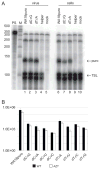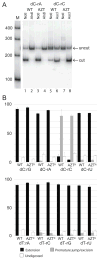Resolution of Specific Nucleotide Mismatches by Wild-Type and AZT-Resistant Reverse Transcriptases during HIV-1 Replication
- PMID: 27075671
- PMCID: PMC4884515
- DOI: 10.1016/j.jmb.2016.04.005
Resolution of Specific Nucleotide Mismatches by Wild-Type and AZT-Resistant Reverse Transcriptases during HIV-1 Replication
Abstract
A key contributor to HIV-1 genetic variation is reverse transcriptase errors. Some mutations result because reverse transcriptase (RT) lacks 3' to 5' proofreading exonuclease and can extend mismatches. However, RT also excises terminal nucleotides to a limited extent, and this activity contributes to AZT resistance. Because HIV-1 mismatch resolution has been studied in vitro but only indirectly during replication, we developed a novel system to study mismatched base pair resolution during HIV-1 replication in cultured cells using vectors that force template switching at defined locations. These vectors generated mismatched reverse transcription intermediates, with proviral products diagnostic of mismatch resolution mechanisms. Outcomes for wild-type (WT) RT and an AZT-resistant (AZT(R)) RT containing a thymidine analog mutation set-D67N, K70R, D215F, and K219Q-were compared. AZT(R) RT did not excise terminal nucleotides more frequently than WT, and for the majority of tested mismatches, both WT and AZT(R) RTs extended mismatches in more than 90% of proviruses. However, striking enzyme-specific differences were observed for one mispair, with WT RT preferentially resolving dC-rC pairs either by excising the mismatched base or switching templates prematurely, while AZT(R) RT primarily misaligned the primer strand, causing deletions via dislocation mutagenesis. Overall, the results confirmed HIV-1 RT's high capacity for mismatch extension during virus replication and revealed dramatic differences in aberrant intermediate resolution repertoires between WT and AZT(R) RTs on one mismatched replication intermediate. Correlating mismatch extension frequencies observed here with reported viral mutation rates suggests a complex interplay of nucleotide discrimination and mismatch extension drives HIV-1 mutagenesis.
Keywords: forced copy-choice recombination; retroviral error mechanisms.
Copyright © 2016 Elsevier Ltd. All rights reserved.
Figures





Similar articles
-
Effects of the Delta67 complex of mutations in human immunodeficiency virus type 1 reverse transcriptase on nucleoside analog excision.J Virol. 2004 Sep;78(18):9987-97. doi: 10.1128/JVI.78.18.9987-9997.2004. J Virol. 2004. PMID: 15331732 Free PMC article.
-
Transmitted human immunodeficiency virus type 1 carrying the D67N or K219Q/E mutation evolves rapidly to zidovudine resistance in vitro and shows a high replicative fitness in the presence of zidovudine.J Virol. 2004 Jul;78(14):7545-52. doi: 10.1128/JVI.78.14.7545-7552.2004. J Virol. 2004. PMID: 15220429 Free PMC article.
-
The L74V mutation in human immunodeficiency virus type 1 reverse transcriptase counteracts enhanced excision of zidovudine monophosphate associated with thymidine analog resistance mutations.Antimicrob Agents Chemother. 2005 Jul;49(7):2648-56. doi: 10.1128/AAC.49.7.2648-2656.2005. Antimicrob Agents Chemother. 2005. PMID: 15980332 Free PMC article.
-
Mutational patterns in the HIV genome and cross-resistance following nucleoside and nucleotide analogue drug exposure.Antivir Ther. 2001;6 Suppl 3:25-44. Antivir Ther. 2001. PMID: 11678471 Review.
-
HIV-1 reverse transcription.Cold Spring Harb Perspect Med. 2012 Oct 1;2(10):a006882. doi: 10.1101/cshperspect.a006882. Cold Spring Harb Perspect Med. 2012. PMID: 23028129 Free PMC article. Review.
Cited by
-
Stable integrant-specific differences in bimodal HIV-1 expression patterns revealed by high-throughput analysis.PLoS Pathog. 2019 Oct 4;15(10):e1007903. doi: 10.1371/journal.ppat.1007903. eCollection 2019 Oct. PLoS Pathog. 2019. PMID: 31584995 Free PMC article.
-
Mutation Rates, Mutation Frequencies, and Proofreading-Repair Activities in RNA Virus Genetics.Viruses. 2021 Sep 21;13(9):1882. doi: 10.3390/v13091882. Viruses. 2021. PMID: 34578463 Free PMC article. Review.
-
A Model of Non-Homologous Recombination Mediated by HIV-1 Reverse Transcriptase Explaining Sequence Motif Duplications That Confer a Replication Fitness Advantage.Viruses. 2025 May 7;17(5):680. doi: 10.3390/v17050680. Viruses. 2025. PMID: 40431692 Free PMC article.
-
HIV-1 single transcription start site mutants display complementary replication functions that are restored by reversion.bioRxiv [Preprint]. 2024 Dec 4:2024.12.04.626847. doi: 10.1101/2024.12.04.626847. bioRxiv. 2024. Update in: J Virol. 2025 Apr 15;99(4):e0213924. doi: 10.1128/jvi.02139-24. PMID: 39677600 Free PMC article. Updated. Preprint.
-
HIV-1 single-transcription start-site mutants display complementary replication functions that are restored by reversion.J Virol. 2025 Apr 15;99(4):e0213924. doi: 10.1128/jvi.02139-24. Epub 2025 Mar 4. J Virol. 2025. PMID: 40035516 Free PMC article.
References
-
- Wain-Hobson S. Human immunodeficiency virus type 1 quasispecies in vivo and ex vivo. Curr Top Microbiol Immunol. 1992;176:181–93. - PubMed
-
- Malim MH, Emerman M. HIV-1 accessory proteins--ensuring viral survival in a hostile environment. Cell Host Microbe. 2008;3(6):388–98. - PubMed
-
- O’Neil PK, et al. Mutational analysis of HIV-1 long terminal repeats to explore the relative contribution of reverse transcriptase and RNA polymerase II to viral mutagenesis. J Biol Chem. 2002;277(41):38053–61. - PubMed
-
- Preston BD, Dougherty JP. Mechanisms of retroviral mutation. Trends Microbiol. 1996;4(1):16–21. - PubMed
Publication types
MeSH terms
Substances
Grants and funding
LinkOut - more resources
Full Text Sources
Other Literature Sources

